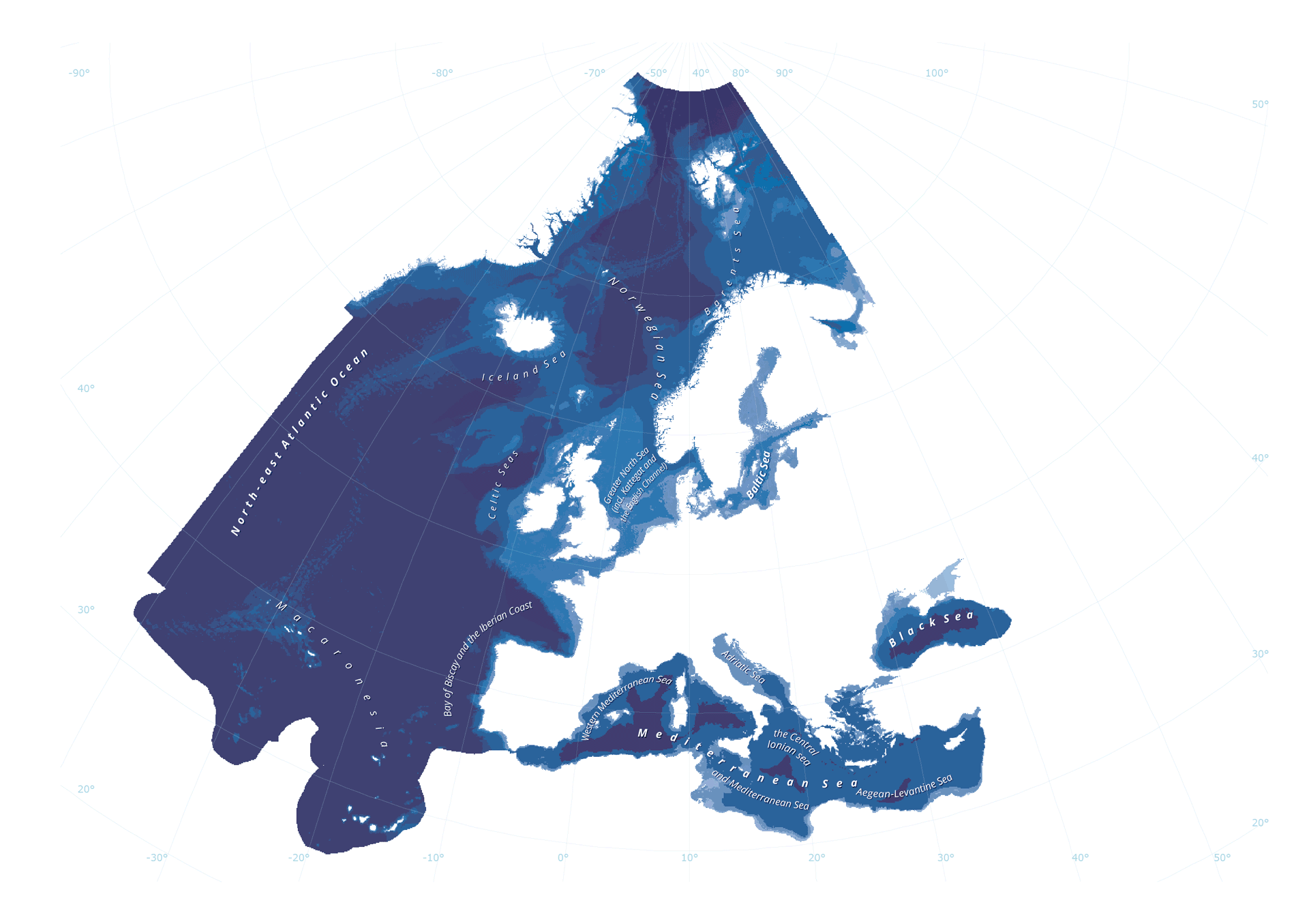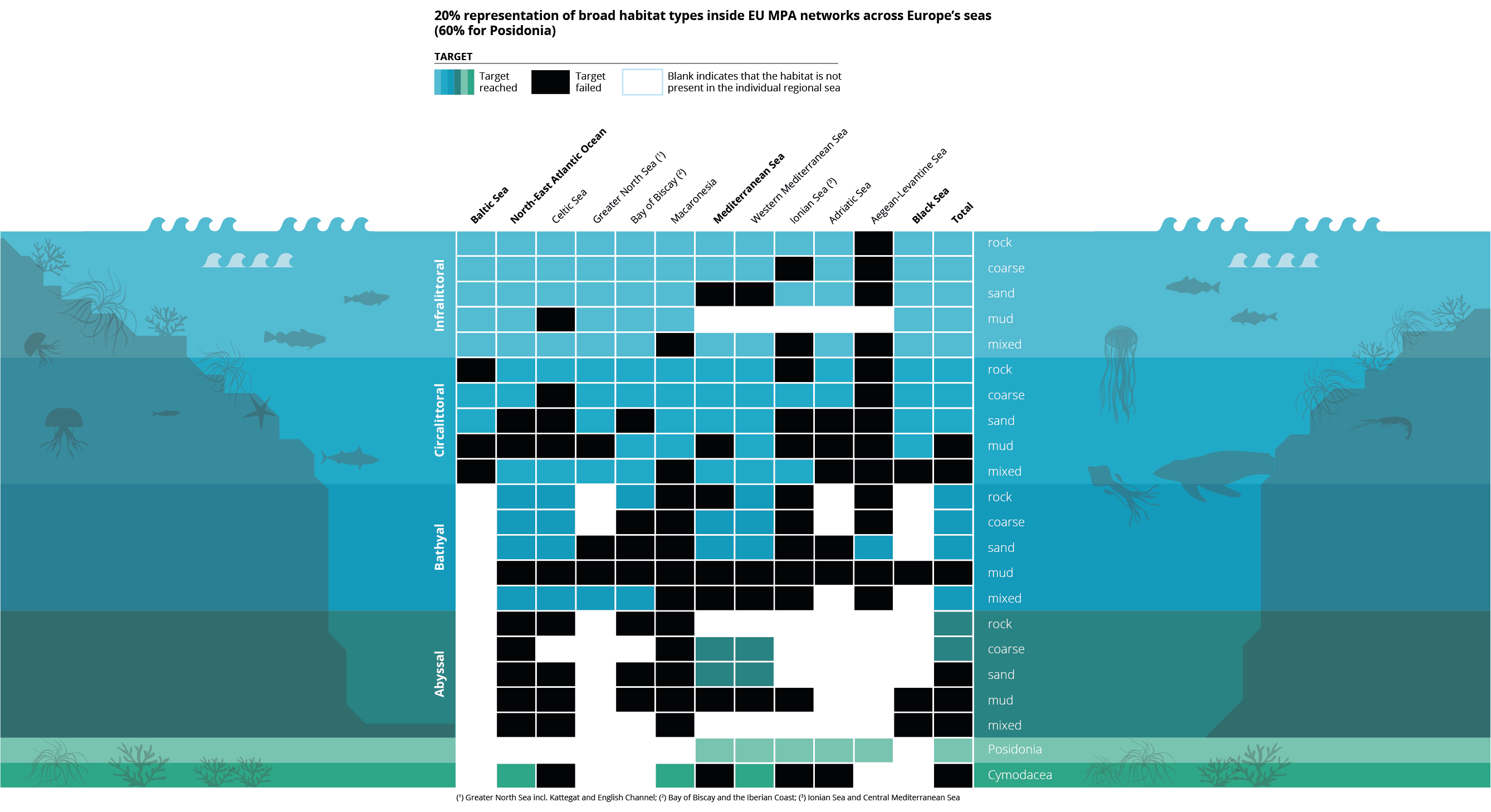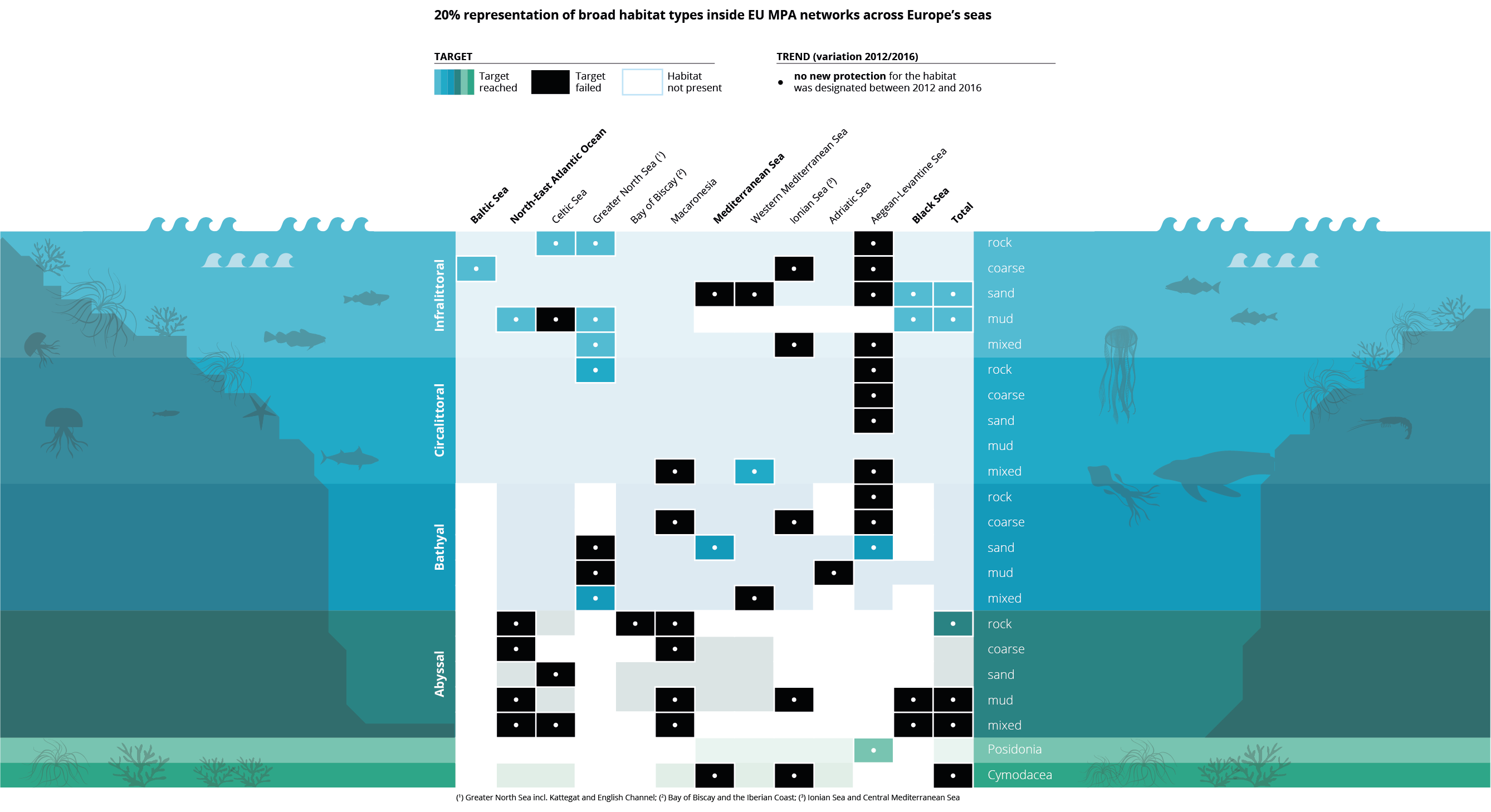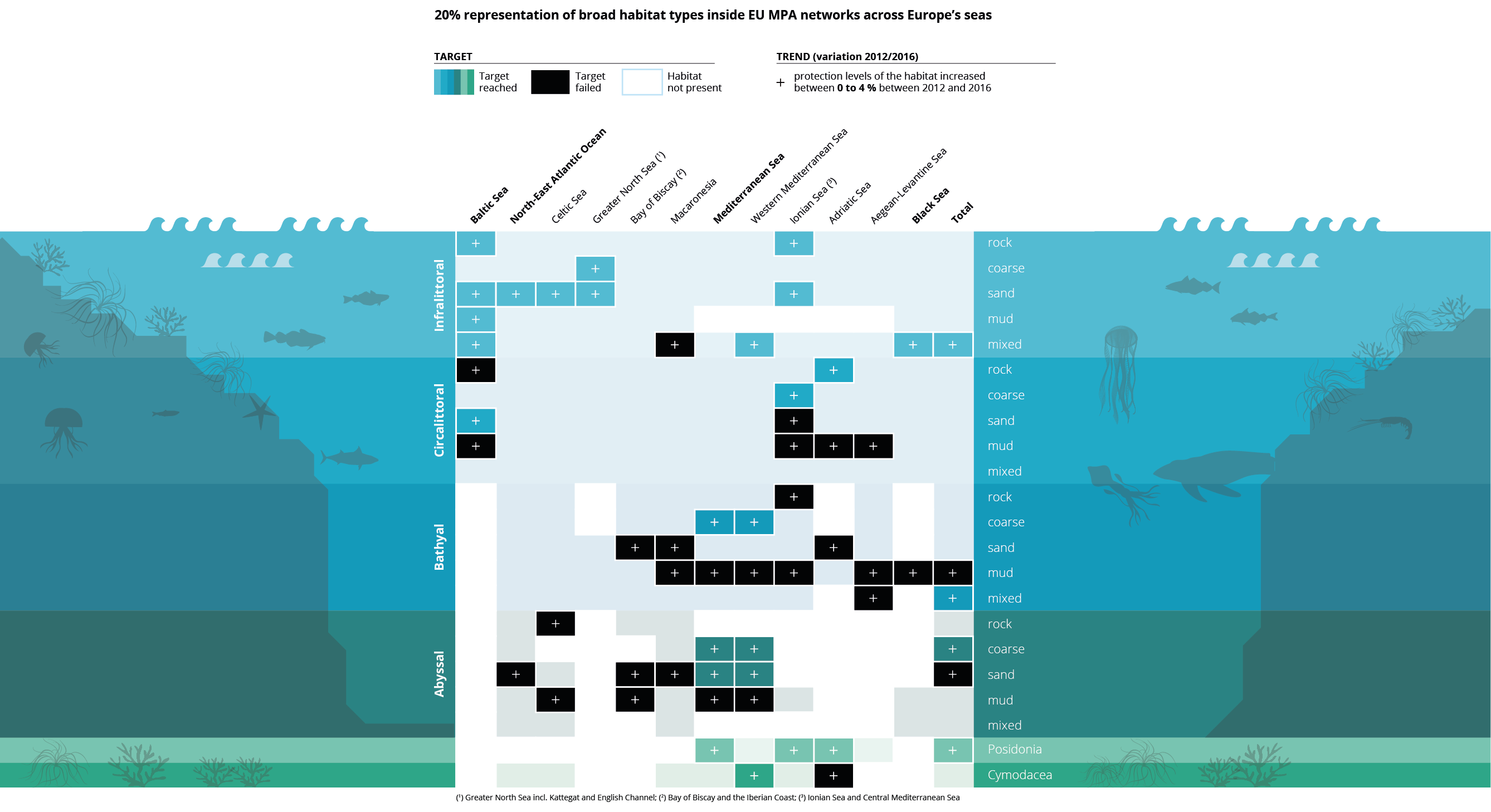Europe's vast and diverse regional seas
Europe's seas cover an area larger than the continent itself. They drive our weather systems, produce the oxygen in the air we breathe, provide us with food and energy, and host some of the most diverse ecosystems on the planet.
However, for living organisms, conditions in Europe's seas are changing faster than ever. This has impacts on marine ecosystems and their biodiversity, and jeopardises the services they provide to our societies. These changes are caused by human induced climate change, increasing resource use (e.g. for food, energy and mineral extraction) and associated pollution.
Protecting Europe's regional seas
Marine protected areas (MPAs) are geographically distinct zones for which protection objectives are set. They constitute a globally connected system for safeguarding biodiversity and maintaining marine ecosystem health and the supply of ecosystem services.
Marine reserves form a subset of MPAs in which impacts from human activities such as resource extraction and fisheries are not permitted.
Networks of MPAs or marine reserves operate together at various scales and cover a range of protection levels, which work towards objectives that individual MPAs cannot achieve.
Europe's regional seas

Note to the map: Europe's regional seas are defined as shown on the map. For full disclosure see document on EU marine regions.
The European Union has made significant progress towards globally agreed targets for establishing marine protected areas
The European Union (EU) has acted on its responsibility to maintain the health of its seas. As such political commitments including specific EU legislation, have been made by both the EU and individual countries.
One of the key policy commitments is Aichi Target 11 under the Convention on Biological Diversity:
"By 2020 […] 10 % of coastal and marine areas, especially areas of particular importance for biodiversity and
ecosystem services, are conserved through effectively and equitably managed, ecologically representative
and well-connected systems of protected areas and other effective area‑based conservation measures, and
integrated into the wider […] seascape".

Source: ETC/ICM - Spatial Analysis of Marine Protected Area Networks in Europe's Seas II, Volume A, 2017
Data from table 3.7 p.35 and table 3.6 p.34
By the end of 2016, 10.8 % of the surface of Europe's seas had been designated as MPAs
By 2016, a total of 27.1 % of the Greater North Sea was covered by MPAs; the highest proportion of any European regional sea. By contrast, the only regional sea where no new MPAs were designated between 2012 and 2016 was the Aegean‑Levantine Sea. It also remained the sea with the lowest MPA coverage at 2.9 %. Overall, more MPA coverage is required, especially in the Macaronesia region and the Mediterranean Sea as a whole.

Source: ETC/ICM - Spatial Analysis of Marine Protected Area Networks in Europe's Seas II, Volume A, 2017
Data from Table 2.2. p.12, Table 3.7, p.35 and Table 3.9 p.38
MPA coverage has improved in nine out of ten regional seas since 2012
By 2016, a total of 27.1 % of the Greater North Sea is covered by MPAs, the highest proportion of any European sea. By contrast, only in the Aegean-Levantine Sea were no new MPAs designated between 2012 and 2016. At 2.9 %, it remains the regional sea with the lowest MPA coverage.
Distribution of MPAs is skewed towards coastal water
Biodiversity is rich where land and sea meet, but the near-shore area makes up only a small portion of Europe's seas compared with the vast offshore seas. Despite this, MPA coverage across Europe's regional seas is more than six times higher in coastal waters than in offshore waters. As such, not all biodiversity features are adequately represented in the MPA network. This includes large zones of the deep sea.

Source: ETC/ICM - Spatial Analysis of Marine Protected Area Networks in Europe's Seas II, Volume A, 2017
Data from Table 3.6 p.34 and Table 3.8 p.37
Europe's MPA network is not yet ecologically representative
To be representative, an MPA network must protect the range of biodiversity found in the area it covers. To do this, an MPA must cover a representative proportion of the habitats present there.
Comparing broad-scale habitat with EU MPA network maps shows that some deeper sea habitats are not represented within the network. Therefore, the MPA network cannot be considered ecologically representative despite having met Aichi target 11.
Moreover, there has not yet been a review of the degree to which these broad-scale habitats are considered to be protected by current or planned management regimes for individual MPAs.
Source: ETC/ICM - Spatial Analysis of Marine Protected Area Networks in Europe's Seas II, Volume A, 2017
Data from Table 3.11 p.40
Larger sites are needed to supplement European MPA networks
Many existing sites may be good for protecting single vulnerable biodiversity features. However, such sites may be too small to sustain ecosystem resilience and hence, they do not fully deliver ecosystem services.
Approximately 50 % of EU MPAs measure less than 30 km2 and a high proportion of these are below 5 km2
Larger MPAs could improve the provision of services from European seas through a systems approach to spatial conservation action. This could contribute to the spill-over effect of fish biomass, which would support fisheries outside the sites, while protecting biodiversity inside. As such, Europe should consider the establishment of larger MPAs beyond coastal waters as part of future designation efforts.

Natura 2000 in the marine environment ensures the conservation of a wide range of rare, vulnerable or threatened marine species.
Natura 2000 marine coverage
The EU's Natura 2000, is the largest coordinated network of protected areas in the world. Natura 2000 in the marine environment is a subset of the main network with designated areas in the marine waters of 23 countries. These sites aim to conserve a wide range of rare, vulnerable or threatened marine species as well as certain rare and characteristic marine habitats.
In 2017, marine Natura 2000 sites covered 515 000 km2 or 8.9 % of Europe's seas, although they too are mainly in near-shore and coastal waters

Source: Natura 2000 barometer data
Data from Table 2.2. p.12, Table 3.7, p.35 and Table 3.9 p.38
Management and conservation of marine Natura 2000 sites
Individual MPAs must be managed so as to deliver conservation benefits. This includes identifying threats to the biodiversity for which an MPA was established and taking appropriate action to manage them.
Analysis of marine Natura 2000 sites shows that that the surface of the Natura 2000 network — which was established in 2012 — was covered by conservation regimes in most regional seas by 2016 (with the exception of the Adriatic, Aegean and Ionian Seas). Overall, in the last 4 years, the number of marine Natura 2000 sites with conservation measures has increased.

Reflections for the future
With entire networks of MPAs across Europe's seas designated, the next steps to ensure they deliver the best possible benefits for marine biodiversity are as follows:
- better capture the biodiversity components protected within MPAs;
- improve our understanding of how marine systems are interconnected to better designate and plan MPAs across Europe, and improve the connectivity and representativity of MPA networks;
- better manage MPAs and consider how to yield the greatest conservation benefits from individual MPA designations;
- improve reporting mechanisms and data flows across Europe, particularly in the areas with protected species and habitats of protected features and ecosystem components;
- share knowledge and experience of the response of European marine life to pressures, and the results of management regimes intended to protect it;
- accurately measure the degree to which MPAs and the network as a whole are achieving their intended purpose.
Further reading
- Protecting marine life in Europe’s seas (article)
- European Protected Areas (article)
- Marine protected areas in Europe's seas (publication)
- Natura 2000 Barometer (data visualisation)
- Europe's seas (dataset)




